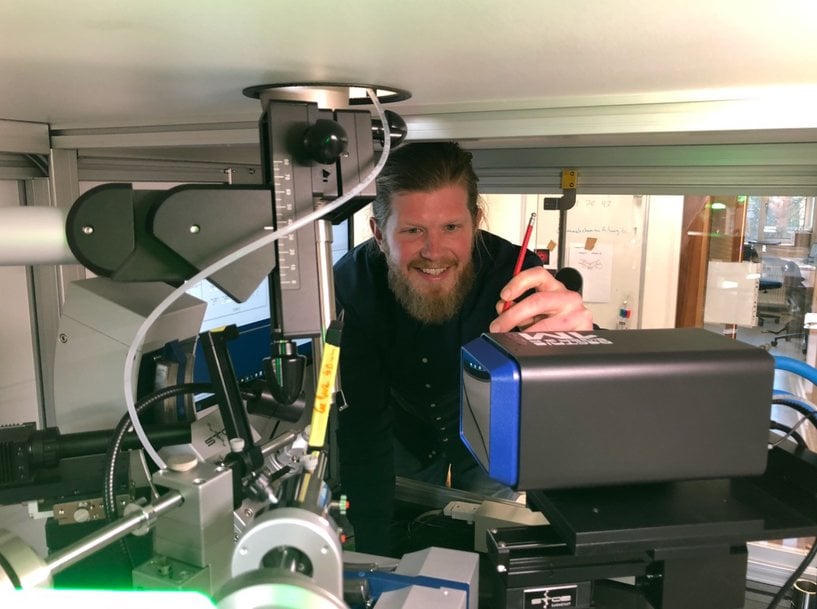electronics-journal.com
22
'22
Written on Modified on
A Multipurpose Crystallography Lab in Aarhus
When it comes to crystallography labs, one size definitely does not fit all. At the University of Aarhus, the idea is to run the lab like a multipurpose beamline. Dr. Jakob Voldum Ahlburg, the lab Manager, shares some insights into what this means.

How do you define a “crystallography lab”? Is it a place where a crystallographer provides measurement, data interpretation, and teaching services to various research groups? Is it a mail-in office where a scientist or a technician collects diffraction data, which are then interpreted by users? Or, is it a platform where users can use the diffractometers and interpret the data, too?
“At Aarhus University, we gravitate towards the third definition”, says Dr. Jakob Voldum Ahlburg, manager of the X-ray facility. With his background in Materials Chemistry and his design of neutron diffraction equipment, Jakob is the person to bring this definition to life. “The idea is to balance two perspectives: current needs of chemists and new opportunities that modern instrumentation can provide”, he comments.
The crystallography lab is part of the Centre for Integrated Materials (iMAT) at Aarhus University. The Centre is focused on Materials Science applications across several fields: Chemistry, Engineering, Physics, Nanoscience, and Geology. With such a wide span of activities and materials, the researchers are using a variety of analytical methods. “Our X-ray platform was set up as a joint initiative of several professors, who pooled their existing diffractometers or invested resources to ensure new instrumentation”, explains Jakob. When he joined the lab in October 2021, there were four single-crystal diffractometers and three powder diffractometers in the Centre. Of these, three were new*. “My job started with three big projects: envisaging the use of all diffractometers, testing the new equipment, and organizing work protocols”, he says.
The lab is envisaged as a multipurpose platform, supporting high-throughput and complex experiments. The term “high-throughput” does not relate only to the number of samples, but also to the level of automation. This way, people with little or no experience can create experiments that do not require a lot of user intervention. “For most beginners, automated processes are the ideal starting point, so we make sure to give them access to instrumentation”, Jakob says. “However, it is also important to grow a community of advanced users, who don’t treat a diffractometer as a black box”. Should this approach sound familiar, you probably feel that way because some versions of it can be seen at synchrotron beamlines. And this is no coincidence. Users of the crystallography lab at Aarhus are also frequent visitors to synchrotron sources, such as MAXIV, SPring-8, and PETRA III at DESY.
“Having high-end equipment in-house means that the users need to invest more effort into working with it. But, for the long term, this helps with preparing for synchrotron experiments. Having proof of a good laboratory measurement helps with getting a proposal accepted, and being trained to operate such equipment helps with conducting an experiment at a beamline”, says Jakob.
Currently, Jakob is testing and commissioning new equipment. The STOE STADIVARI single-crystal diffractometer is equipped with a dual Cu/Mo source, a DECTRIS EIGER2 R 4M detector, and quite a lot of accessories: a hot-air furnace, a cooling device, and a diamond anvil cell. “The plan is to use this diffractometer for advanced experiments: difficult structures, or non-ambient or in-situ measurements. The key aspects are good collaboration with STOE and training of users”, he explains.
Another piece of news in the lab is the upgrade of a STOE STADIP powder diffractometer with an Ag source and four DECTRIS MYTHEN2 detectors. With this setup, a range of 136 °2 θ (or Q = 20.8 Å) can be covered in two shots. This improvement opens new avenues to high-resolution, time-resolved X-ray diffraction, as well as to total scattering studies.
“If I were to summarize my job in a sentence, I would say that it is about making sure that each user has access to the optimal X-ray technique and diffractometer for her/his needs. I like to bring people and machines closer together. My job is similar to that of a beamline scientist, but with better working hours”, concludes Jakob.
We wish Jakob and his users a lot of interesting experiments.
*The three new diffractometers were funded through iMAT. Grants were also issued from Novo Nordisk Foundation / Novo Nordisk Fonden and VILLUM FONDEN # VELUX FONDEN to Professors Anja-Verena Mudring, Dorthe Bomholdt Ravnsbæk, and Bo Brummerstedt Iversen.
www.dectris.com

